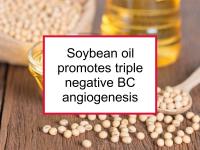Increasing awareness of risks linked to saturated fat and partially-hydrogenated oil intake have left consumers with the impression that cooking with vegetable oil is a healthy choice. However, the omega-6 fatty acid linoleic acid predominant in soybean oil and other common vegetable oils has been linked to breast cancer development.
For example, linoleic acid, an omega-6 fatty acid found in abundance in vegetable oils such as corn oil, safflower oil, soybean oil, and sunflower oil, has been shown to induce the migration and invasion of triple negative (ER-/PR-/HER2-) breast cancer cells. Now a new study has shown that exposure to linoleic acid can induce pro-angiogenic activity in triple negative cells.
Latest research shows how linoleic acid stumulates angiogenesis
The study referenced above was designed to investigate whether linoleic acid induces the secretion of extracellular vesicles by triple negative breast cancer cells and to investigate their potential pro-cancer activities. A vesicle is a tiny, self-contained sac consisting of a membrane that encloses fluid or gas. Vesicles can transport material either within or to the outside of a cell. Extracellular vesicles are secreted by normal cells during routine cellular operations. However, cancer cells can also secrete extracellular vesicles that are involved in tumor progression.
In the study, the authors demonstrated that treating MDA-MB-231 triple negative breast cancer cells with 90 µM linoleic acid for 48 hours caused a higher number of extracellular vesicles to be secreted. These extracellular vesicles were shown to induce FAK and Src activation. Such activation is known to have the potential to promote cell migration, cell cycle progression and cell survival. In fact, the FAK and Src activation associated with linoleic acid exposure did increase migration.
The authors also showed that additional secretion of the extracellular vesicles was a result of FFAR1 and FFAR4 (free fatty acid receptor) activation in human umbilical vein endothelial cells (HUVECs). The extracellular vesicles secreted by triple negative cells treated with linoleic acid were also found to increase proliferation, invasion, MMP secretion (MMP are enzymes that degrade the extracellular matrix, thereby mediating cellular migration), and the formation of new tubules in HUVECs (a sign of angiogenesis, the growth of new blood vessels). The authors conclude that they have demonstrated, for the first time, that treatment with linoleic acid results in the release of extracellular vesicles from triple negative breast cancer cells. Furthermore, these vesicles induce processes shown to be involved with angiogenesis in HUVECs.
Please see our linoleic acid tag for more information.
